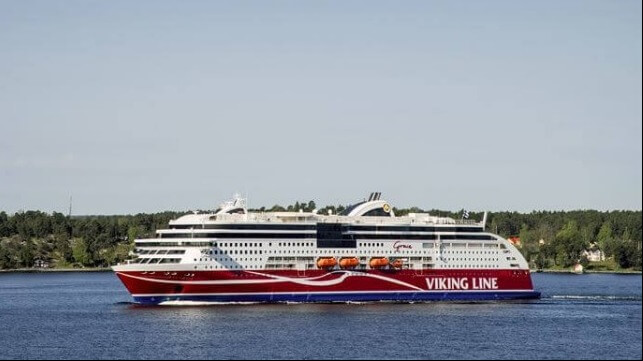Viking Line Passengers Reduce Carbon Footprint by Paying for Biogas

It has been offered to shippers by tankers and containerships and now for the first time, Scandinavian ferry company Viking Line is offering passengers the option of contributing to lower emissions by purchasing biogas for their trip. Starting today, June 21, Viking Line became the first ferry company to offer passengers an option to participate in reducing carbon emissions from their travel.
Viking operates two luxury Ro-Ro ferries, Viking Grace and Viking Glory, making the trip between Stockholm, Sweden and Turku, Finland with an intermediate stop in Aland. The Viking Grace was introduced in 2013 pioneering as an LNG-fueled ferry. She is 57,656 gross tons carrying 2,800 passengers and up to 584 cars. The Viking Glory was introduced last year further elevating the passenger experience. She is 63,800 gross tons also carrying 2,800 passengers and up to 550 cars.
The two passenger ferries make two sailings each day on the route. The trip ranges between approximately eight and 12 hours depending on the time and which vessel.
Under the new program, passengers are offered the option of buying biofuel in proportion to the amount of fuel used for their journal. Passengers will be paying up to €5 in addition to the fare which ranges between €45 and €55. The amount of liquified biogas purchased is based on the average fuel used per passenger with Viking reporting that mixing in biogas reduces the vessel’s carbon emissions and the passenger’s carbon footprint by up to 90 percent.
"We are the first shipping company on the Baltic Sea to offer passengers the option of reducing their carbon footprint by replacing LNG with renewable biofuel," says Dani Lindberg, Sustainability Manager at Viking Line. “Many of our passengers have asked for such an option, and we are really pleased that we can now engage them even more in our work for the environment and the Baltic Sea.”
Both vessels were designed with the capability to run on biogas and synthetic fuels produced from renewable energy. Viking reports it has already tested biogas on the Viking Grace and under the new program, Viking Line purchases biogas with the additional funds paid by passengers. The biogas is made from sustainable sources such as food and agricultural waste with the company receiving sustainability certificates for every biogas delivery.
"We will now work in partnership with Gasum and our environmentally-aware customers to increase the use of biogas,” says Lindberg. “The supply of biogas is still limited compared to demand. For example, all biogas produced in Finland is currently used in manufacturing,” he notes but the company is working to expand the supply.
Currently, Viking is mixing the biogas with the LNG to fuel the vessels due to the supply constraints. The company is also taking part in projects that explore the possibility of creating a carbon-neutral green corridor for the Baltic.
